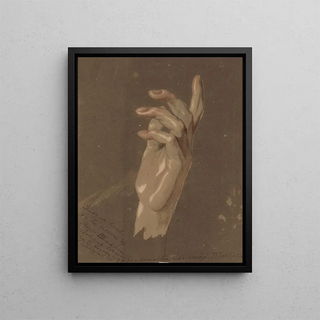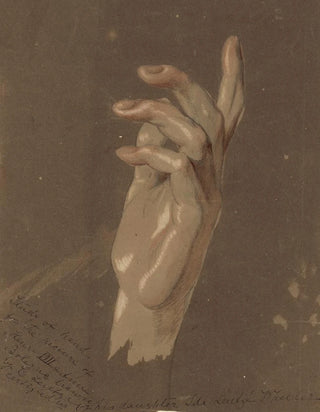Art print | Study of the hand - Emanuel Leutze Source: Reproduction | Étude de la main - Emanuel Leutze


View from behind

Frame (optional)
The artwork "Study of the Hand" by Emanuel Leutze is a captivating piece that transcends mere academic exercise to become a true testament to the art of representation. This study, far from being a simple sketch, reveals the depth of Leutze's artistic thinking, as well as his commitment to capturing human complexity through detail. In this work, the hand, a symbol of creation and expression, is highlighted, inviting the viewer to reflect on the power and delicacy of this essential organ. Contemplating this piece, one is immediately transported into the artist's universe, where every line and shadow tells a story.
Style and uniqueness of the work
Leutze's style is characterized by striking realism, combined with an almost romantic sensitivity. In "Study of the Hand," one can observe meticulous attention to anatomical details, as well as mastery of shadows and lights that give the hand an almost lifelike dimension. The contours are delicately sketched, while shades of gray and white create a depth that draws the eye. This choice of representation highlights not only the artist's technique but also his ability to evoke emotions through simple elements. The hand here becomes a symbol of humanity, a bridge between art and the viewer, capable of conveying feelings of strength, vulnerability, and connection.
The artist and his influence
Emanuel Leutze, born in Germany and having built his career in the United States, is often recognized for his historical works and portraits. However, his work on studies like "Study of the Hand" reveals another facet of his artistic genius. Leutze was influenced by currents such as Romanticism and Realism, but he developed a unique approach that is his own. His ability to combine rigorous technique with personal expression made him a pioneer in the field of academic art. Moreover, his impact on future generations of artists cannot be underestimated, as he paved the way for a deeper exploration of human anatomy and emotion through drawing.

Matte finish

View from behind

Frame (optional)
The artwork "Study of the Hand" by Emanuel Leutze is a captivating piece that transcends mere academic exercise to become a true testament to the art of representation. This study, far from being a simple sketch, reveals the depth of Leutze's artistic thinking, as well as his commitment to capturing human complexity through detail. In this work, the hand, a symbol of creation and expression, is highlighted, inviting the viewer to reflect on the power and delicacy of this essential organ. Contemplating this piece, one is immediately transported into the artist's universe, where every line and shadow tells a story.
Style and uniqueness of the work
Leutze's style is characterized by striking realism, combined with an almost romantic sensitivity. In "Study of the Hand," one can observe meticulous attention to anatomical details, as well as mastery of shadows and lights that give the hand an almost lifelike dimension. The contours are delicately sketched, while shades of gray and white create a depth that draws the eye. This choice of representation highlights not only the artist's technique but also his ability to evoke emotions through simple elements. The hand here becomes a symbol of humanity, a bridge between art and the viewer, capable of conveying feelings of strength, vulnerability, and connection.
The artist and his influence
Emanuel Leutze, born in Germany and having built his career in the United States, is often recognized for his historical works and portraits. However, his work on studies like "Study of the Hand" reveals another facet of his artistic genius. Leutze was influenced by currents such as Romanticism and Realism, but he developed a unique approach that is his own. His ability to combine rigorous technique with personal expression made him a pioneer in the field of academic art. Moreover, his impact on future generations of artists cannot be underestimated, as he paved the way for a deeper exploration of human anatomy and emotion through drawing.






